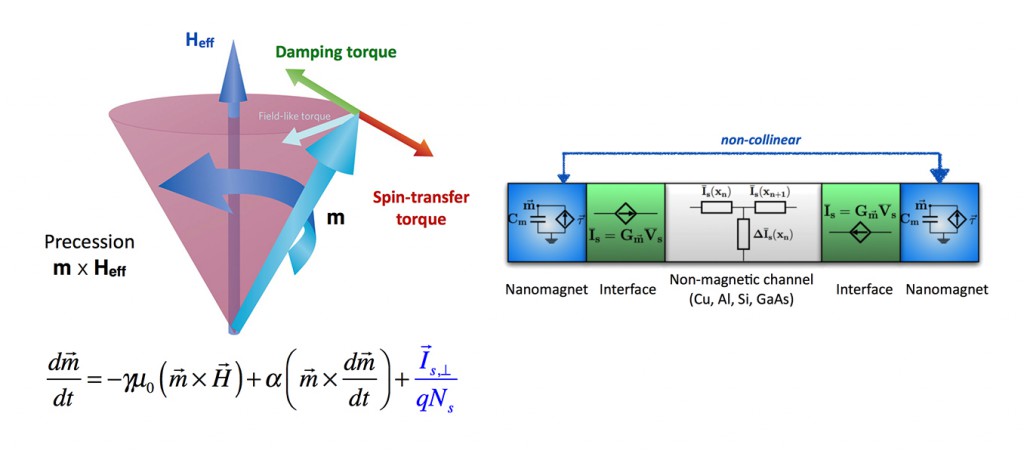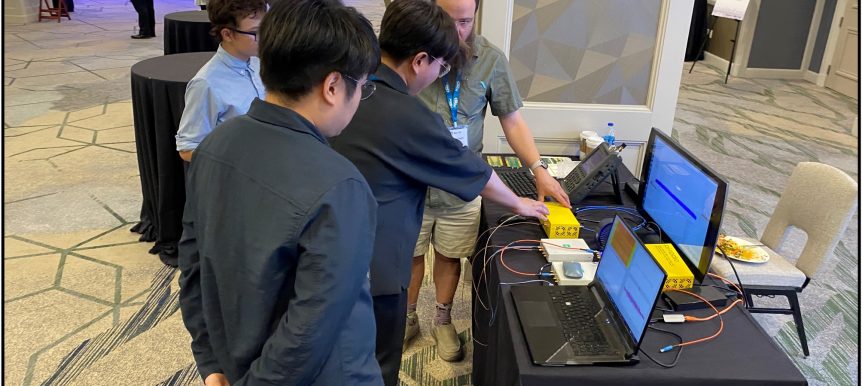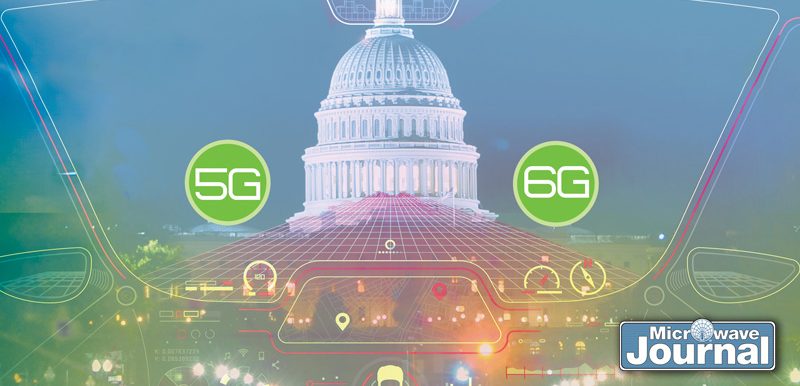Quantum Devices & Circuits
Our research involves the integration of new materials, devices, and circuits to enable high-throughput and low-power beyond 5G communication systems, beyond von Neumann computing, as well as ubiquitous internet-of-things networks. We are theoretically and experimentally investigating a wide-range of electronic and spintronic devices implemented using wide-gap semiconductors (e.g., GaN, GaAs), two-dimensional semiconductors (e.g., graphene, transition metal-dichalcogenides, black phosphorus) and magnetic materials. The distinctive assets of these materials are exploited in unique circuits and architectures to enable new nano-systems providing multi-generational system-level benefits. Our research utilizes the state-of-the-art facilities in NYU including Nanofabrication Center, quantum materials lab at Center for Quantum Phenomena, and high-performance computing center.
Our group is involved in developing novel nanotechnology solutions to the challenges facing giga- and tera-scale integration. This includes using new physical concepts, new materials, creative devices, circuits and architectures to improve system functionalities in the existing semiconductor technologies and implement completely new nano-systems for maximum benefit.
The last few decades have witnessed an unprecedented growth in the performance of the CMOS technology that now has a market share of more than $270 billion. This era also witnessed many new circuits and system concepts to support the momentum of growth in the industry. However, now electrical engineering is at its crossroads. Research in nanoelectronics must undergo a paradigm shift as the CMOS scaling approaches its ultimate limits. The next decade will usher us into an era of new science and disruptive technologies. Research involving the integration of various novel concepts – from new materials to new architectures – is necessary for enabling unique functionality beyond just high-performance general-purpose computing.
From the many research frontiers now expanding, we are specifically working in two areas: (i) terahertz wireless communication to meet the exploding bandwidth demands of the consumers and (ii) developing device and circuits concepts for computing with magnets, which offer the ultimate thermodynamic limits of computation governed by Landauer’s principle.
Computing with magnets

In the last several decades, productivity of the semiconductor technology has increased by a factor of more than a billion. The rapid growth in the semiconductor industry is a direct result of dimensional scaling allowing for microprocessor chips to pack more functionality per cost. However, we are now at the 7nm node (IBM) and continued scaling would only mean more leakage, resulting in an exponential increase in power dissipation. Hence the need of the hour is a beyond CMOS technology that overcomes the hurdles imposed by scaling constraints.
The discovery of the Giant Magnetoresistance (GMR) in 1988 paved the way for spintronics based devices like Magnetic Tunnel Junctions (MTJ) and Magnetic RAMs, and since then spintronics has become a fast emerging frontrunner in this race of beyond CMOS technologies. The use of electron spin, rather than its charge, gives spintronics devices an additional degree of freedom. Among the potential alternatives, devices based on nanoscale magnets in the field of spintronics have received special attention thanks to their advantages in terms of robustness and enhanced functionality. Magnets are non-volatile: their state remains even if the power to the circuit is switched off. Thus, the circuits do not consume power when not used – a very desirable property for modern tablets and smart phones. Virtually near-zero leakage, high integration density and high speeds have made such devices very popular.
We at the Quantum Nanoelectronics Lab at NYU are involved in analyzing the underlying physical principles of nanomagnets and their dynamics, and developing spintronics based magnetic memories and logic devices. By running Monte Carlo simulations for the magnetization dynamics of nanomagnets, we hope to understand the complex interplay between the injected spin current, the pulse duration, the probability of switching, the delay and the energy involved, among other quantities. We are attempting to build an analytical model of the switching mechanisms of nanomagnets, which will allow us to create faster low-power spin-transfer torque MRAMs.
Another facet of our research involves using Giant Spin Hall Effect (GSHE) logic devices for stochastic computing. We are currently developing compact scalable models for stochastic nanomagnet dynamics in the GSHE switch, which will allow us to create a suite of magnetic switches in a stochastic spin library (SSL) containing the timing, energy, and error probability descriptions of spintronic standard cells.
Sub-THz Materials
Our group is involved in developing novel nanotechnology solutions to the challenges facing giga- and tera-scale integration. This includes using new physical concepts, new materials, creative devices, circuits and architectures to improve system functionalities in the existing semiconductor technologies and implement completely new nano-systems for maximum benefit.
Current Research
RESEARCH PAPERS
| Citation | View Papers | Research Areas | Date |
|---|---|---|---|
P. Skrimponis, S. Hadi Mirfarshbafan, C. Studer and S. Rangan, “Power Efficient Multi-Carrier Baseband Processing for 5G and 6G Wireless,” 2020 54th Asilomar Conference on Signals, Systems, and Computers, 2020, pp. 324-330, doi: 10.1109/IEEECONF51394.2020.9443544. | Affiliate Access Only | quantum devices, terahertz | June 3, 2021 |
D. Shakya, T. Wu, M. E. Knox, and T. S. Rappaport, ”A Wideband Sliding Correlation Channel Sounder in 65 nm CMOS: Evaluation Board Performance,” in IEEE Transactions on Circuits and Systems II: Express Briefs, Jun. 2021, pp. 1–5 | Affiliate Access Only | quantum devices, testbeds | June 1, 2021 |
P. Skrimponis, N. Hosseinzadeh, A. Khalili, E. Erkip, M. J. W. Rodwell, J. F. Buckwalter, and S. Rangan, “Towards Energy Efficient Mobile Wireless Receivers Above 100 GHz,” in IEEE Access, vol. 9, pp. 20704-20716, 2021, doi: 10.1109/ACCESS.2020.3044849. | Affiliate Access Only | quantum devices, terahertz | December 15, 2020 |
D. Shakya, T. Wu and T. S. Rappaport, “A Wideband Sliding Correlator based Channel Sounder in 65 nm CMOS: An Evaluation Board Design,” GLOBECOM 2020 – 2020 IEEE Global Communications Conference, Taipei, Taiwan, 2020, pp. 1-6, DOI: 10.1109/GLOBECOM42002.2020.9322622. | Affiliate Access Only | quantum devices, testbeds | December 11, 2020 |
Y. Wang, Z. Jiao, Q. Yao, L.M. Balescu, Q. Liu, B. Tang, H.J.W. Zandvliet, “Structural and electronic properties of the α-GeSe surface,” Surface science 686, 17-21, Aug. 2019 | Affiliate Access Only | mobile edge, quantum devices | August 1, 2019 |
R Li, X Zhang, L Miao, L Stewart, E Kotta, D Qian, D. Shahrjerdi, “Second derivative analysis and alternative data filters for multi-dimensional spectroscopies: a Fourier-space perspective,” Journal of Electron Spectroscopy and Related Phenomena, June 2019 | Affiliate Access Only | quantum devices | June 23, 2019 |
A. Manickam1, K.D. You, N. Wood, L. Pei, Y. Liu, D. Shahrjerdi, “11.2 A CMOS Biosensor Array with 1024 3-Electrode Voltammetry Pixels and 93dB Dynamic Range,” IEEE International Solid- State Circuits Conference – (ISSCC), Feb. 2019 | Affiliate Access Only | quantum devices | February 14, 2019 |
D. Shahrjerdi, A. Manickam, K.D. You, N. Wood, L. Pei, Y. Liu, R. Singh, N. Gamini, “11.2 A CMOS Biosensor Array with 1024 3-Electrode Voltammetry Pixels and 93dB Dynamic Range,” 2019 IEEE International Solid-State Circuits Conference-(ISSCC), Feb 2019 | Affiliate Access Only | quantum devices | February 12, 2019 |
T. Wu, A. Alharbi, R. Kiani, D. Shahrjerdi, “Graphene Electrodes: Quantitative Principles for Precise Engineering of Sensitivity in Graphene Electrochemical Sensors,” Advanced Materials, Feb 2019 | Affiliate Access Only | quantum devices | February 1, 2019 |
Jeff Jun Zhang, Siddharth Garg, “FATE: fast and accurate timing error prediction framework for low power DNN accelerator design,” ICCAD 2018: 24 | Affiliate Access Only | Lower Power ADCs | November 5, 2018 |
Jeff Zhang, Kartheek Rangineni, Zahra Ghodsi, Siddharth Garg, “Thundervolt: enabling aggressive voltage underscaling and timing error resilience for energy efficient deep learning accelerators,” DAC 2018: 19:1-19:6 | Affiliate Access Only | Lower Power ADCs | June 18, 2018 |
S. Sun, T.S. Rappaport, M. Shafi, P. Tang, J. Zhang, P. J. Smith, “Propagation Models and Performance Evaluation for 5G Millimeter-Wave Bands,” in IEEE Transactions on Vehicular Technology, June 2018. | Affiliate Access Only | mmwave rappaport, quantum devices, terahertz | June 1, 2018 |
Jeff Jun Zhang, Tianyu Gu, Kanad Basu, Siddharth Garg, “Analyzing and mitigating the impact of permanent faults on a systolic array based neural network accelerator,” VTS 2018: 1-6 | Affiliate Access Only | Lower Power ADCs | April 22, 2018 |
V. Petrov, D. Moltchanov, M. Komar, A. Antonov, P. Kustarev, S. Rakheja, and Y. | Affiliate Access Only | iii-nitride, quantum devices | April 11, 2017 |
R. Pujari, S. Rakheja “Performance Evaluation of Copper and Graphene Nanoribbon in 2D Network-On-Chip Structures,” In The 18th International Symposium on Quality Electronic Design (ISQED), Santa Clara, California, March 13 – 15, 2017. | Affiliate Access Only | quantum devices | March 13, 2017 |
S. Rakheja “Communication Limits of On-Chip Graphene Plasmonic Interconnects” In The 18th International Symposium on Quality Electronic Design (ISQED), Santa Clara, California, March 13 – 15, 2017. | Affiliate Access Only | quantum devices | March 13, 2017 |
K. Li, S. Rakheja. Optimal III-nitride HEMTs: From Materials and Device Design to Compact Model of the 2DEG Charge Density. In SPIE Proceedings: Gallium Nitride Materials and Devices XII, vol. 10104, p. 1010418-1 – 1010418-16, Feb. 2017. | Affiliate Access Only | iii-nitride, quantum devices | February 1, 2017 |
S. Farzaneh, S. Rakheja “Plasmon Propagation in Gated Bilayer Graphene” In The International Society for Optics and Photonics (SPIE) – Photonics West, San Francisco, California, Jan. 28 – Feb. 02, 2017. | Affiliate Access Only | quantum devices | January 28, 2017 |
S. Rakheja. On the Gaussian Pulse Propagation Through Multilayer Graphene Plasmonic Waveguides – Impact of Electrostatic Screening and Frequency Dispersion on Group Velocity and Pulse Distortion. IEEE Transactions on NanoTechnology, vol. 15, no. 6, pp. 936–946, Nov. 2016. | Affiliate Access Only | quantum devices | November 1, 2016 |
S. Rakheja, P. Sengupta, K. Li. Challenges and Opportunities in Modeling Gallium Nitride High Electron Mobility Transistors – From Numerical Simulations to Compact Transistor Model. In International Workshop on Nitride Semiconductors (IWN), Orlando, Florida, Oct. 02 07, 2016. | Affiliate Access Only | iii-nitride | October 2, 2016 |
S. Rakheja and D. Antoniadis. MIT MVS Models. | Affiliate Access Only | iii-nitride | April 11, 2016 |
S. Rakheja and P. Sengupta “The Tuning of Light-Matter Coupling and Dichroism in Graphene for Enhanced Absorption: Implications for Graphene-based Optical Absorption Devices” Journal of Physics D: Applied Physics, vol. 49, no. 11, p. 115106, 2016. | Affiliate Access Only | quantum devices | January 24, 2016 |
S.Rakheja and P. Sengupta “Gate-Voltage Tunability of Plasmons in Single-layer Graphene Structures – Analytical Description, Impact of Interface States, and Concepts for Terahertz Devices” IEEE Transactions on Nanotechnology, vol. 15, no. 1, pp. 113-121, Jan. 2016. | Affiliate Access Only | quantum devices | January 1, 2016 |
S. Rakheja and D.A. Antoniadis, “Physics-based Compact Modeling of Charge Transport in Nanoscale Electronic Devices,” In IEEE Electron Devices Meeting (IEDM), Washington D.C., Dec. 07 – 12, 2015. | Affiliate Access Only | iii-nitride | December 7, 2015 |
S. Rakheja and P. Sengupta “Design of Graphene-based Optical Modulators via Tuning of Surface Plasmon Resonance and Dielectric Constants” In Materials Research Society (MRS) Meeting, Boston, Massachusetts, Nov. 29 – Dec. 04, 2015. | Affiliate Access Only | quantum devices | November 29, 2015 |
S.Rakheja, M. Lundstrom, and D. Antoniadis. An Improved Virtual-Source-Based Transport Model for Quasi-Ballistic Transistors – Part II: Experimental Verification. IEEE Transactions on Electron Devices, vol. 62, no. 9, pp. 2794–2801, Sep. 2015. | Affiliate Access Only | iii-nitride | September 1, 2015 |
S.Rakheja, M.Lundstrom, and D.Antoniadis. An Improved Virtual-Source-Based Transport Model For Quasi-Ballistic Transistors – Part I: Capturing Effects of Carrier Degeneracy, Drain- Bias Dependence of Gate Capacitance, and Non-Linear Channel-Access Resistance. IEEE Transactions on Electron Devices, vol. 62, no. 9, pp. 2786–2793, Sep. 2015. | Affiliate Access Only | iii-nitride | September 1, 2015 |
S. Rakheja, “Fundamental Limits of Energy Dissipation in Spintronic Interconnects Using Optical Spin Pumping,” NANOARCH, July 8-10, 2015. | Affiliate Access Only | Next Generation Electronics | July 8, 2015 |
V. Kumar, S. Rakheja, A. Naeemi “High-Frequency Models for Multilayer Graphene Interconnects,” In International Microwave Symposium (IMS), Phoenix, Arizona, May 17 – 22, 2015. | Affiliate Access Only | quantum devices | May 17, 2015 |
O. Orhan, E. Erkip, S. Rangan, “Low Power Analog-to-Digital Conversion in Millimeter Wave Systems: Impact of Resolution and Bandwidth on Performance” Proc. Information Theory and Applications Workshop (ITA), Proc. ITA, San Diego, Feb. 2015. | Affiliate Access Only | Low-Power Fully Digital Transceivers, mmwave | February 1, 2015 |
S. Rakheja, M. Lundstrom, and D.A. Antoniadis. A Physics-Based Compact Model for FETs from Diffusive to Ballistic Carrier Transport regimes. In IEEE Electron Devices Meeting (IEDM), San Francisco, California, Dec. 15 – 17, 2014. | Affiliate Access Only | iii-nitride | December 15, 2014 |
C. N. Barati, S. A. Hosseini, S. Rangan, P. Liu, T. Korakis, S. S. Panwar, and T. S. Rappaport, “Directional Cell Search for Millimeter Wave Cellular Systems,” Proc. IEEE Signal Processing Advances in Wireless Communications (SPAWC), Toronto, Canada, pp. 120-124, June 2014. | Affiliate Access Only | Low-Power Fully Digital Transceivers, Network Design, terahertz, testbeds | June 22, 2014 |
P. Bonhomme, S. Manipatruni, R. Mousavi, S. Rakheja, D.E. Nikonov, I.A. Young, A. Naeemi, “Circuit simulation of magnetization dynamics and spin transport,” IEEE Transactions on Electron Devices, vol. 61, no. 5, May 2014. | Affiliate Access Only | Next Generation Electronics | March 28, 2014 |
S. Rakheja, A. Naeemi, “Communicating novel computational state variables in post-CMOS logic,” IEEE Nanotechnology Magazine, vol. 7, no. 1, 2013. | Affiliate Access Only | Next Generation Electronics | February 5, 2013 |

 The Pi-Radio FR3 SDR is Operational
The Pi-Radio FR3 SDR is Operational NSF Grant Awarded to Assist People with Blindness and Low Vision
NSF Grant Awarded to Assist People with Blindness and Low Vision New Metric for Evaluating Power Efficiency
New Metric for Evaluating Power Efficiency








